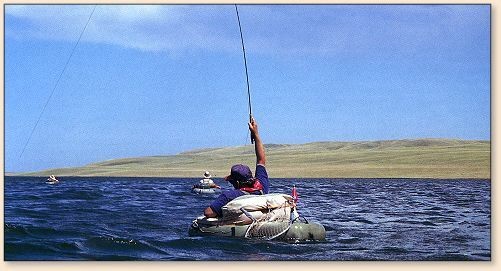Exploratory Casting
Since fish usually travel around the lake in
schools searching for food, your challenge is
to find out where they are at a particular time.
Much of the lake does not hold fish, thus you
need to locate spots that are most likely to
attract fish. Chapter 4 gives you more information
on trout habitat to help you with your search for
fish. Once you have found a likely spot, position
yourself about 30 feet off shore or where your
soundings indicate a drop off.
When you are ready to cast, remove the fly from
the keeper and while remaining stationary, begin
to work out line by false casting. You should try
to cast out most of the fly line on your reel so
that you will have a longer retrieve. When you are
executing the false cast to let out more line, try
to make your casts in a different direction from
the one that you plan to fish in order not to frighten
the fish. When you are ready to release the fly,
turn your body in the direction you plan to fish.
For example, if you are searching from left to right,
you would false cast further to the left than where
you plan to fish. If you have limited casting ability
and want more line out, simply strip more line from
your stripping apron and toss it into the water as
your line is sinking. At the same time you are paying
out line you need to kick backward in order to keep
the line well ahead of you.
Also, in regard to casting, you need to know that
sinking lines are quite heavy and cannot be easily
lifted off the water especially when they have sunk
to the bottom. To counteract the weighty line, you
need to strip most of the line in onto the stripping
apron before attempting to execute another cast.
After the cast let your fly sink down to the bottom
(the line will straighten out at the end of your rod
tip). Or if you know the depth from your sounding and
the sink rate for your line, you can count your fly
down to the bottom or to a spot just above a weed bed.
For example, if the depth is 10 feet and the sink rate
is 2.5 inches per second, when you count 48 seconds,
you should be on the bottom. Then slowly retrieve your
fly. If no fish strikes the fly at that depth, try
different depths by decreasing your countdown.
Fan Casting
From a stationary vantage point 30 feet out from shore,
make casts in increments that assume the shape of a fan
from your left to right facing toward the middle of
the lake. Then turn facing the shore and do the same
thing toward the shoreline. Using this method, you
will be able to cover the water where trout are most
likely to be either cruising the shallows or near
the bottom around weed beds.
Parallel Casting
Another exploratory method is to kick and fish
parallel to the shore, staying about 30 feet out
from shore. In this method, cast from a stationary
position, but kick backwards when retrieving.
Alternately cast directly ahead, toward the middle
of the lake, or toward the shore. And, by kicking
in an S pattern as you parallel the shore you can
also take advantage of possible drop offs where fish
might be looking for food. When fishing in a relatively
small lake and casting toward shore, it is more
convenient to fish counter clockwise around the
lake if you are right handed and clockwise if left
handed. This way you never need to cast back handed.
You should also vary the speed of your kicking to
see what effect that has on attracting fish to your
fly.

Trolling
Trolling is an excellent way to explore a lake.
Although this method is not considered by some
to be fly fishing, it is another way to find fish
and it is quite relaxing. For trolling, simply
cast up to 50 feet of line and let your fly sink
to the depth you want without retrieving. Keep
the fly moving at different speeds by adjusting
your kick. If you want to fish on or near the
bottom, use a line with a fast sink rate and
troll at a slow speed so that the line will
sink deeply and you are able to keep your fly
on the bottom longer. If you are trolling for
fish nearer the surface, use a slow sink rate
line and a fast kick speed. Sometimes, you can be
quite surprised by a big fish when trolling, so
while not having to retrieve, do be prepared to
strike. It is amazing how many times a fish will
strike when you become distracted perhaps by
watching something else or talking with a fellow
fisherman. If you have tried different depths,
different speeds and different types of retrieves
with no fish pulling on your line, then it is time
to try a different fly to see if that is the missing
variable in your search for feeding fish. A good
rule of thumb is to thoroughly fish a fly for 20-30
minutes before changing to another fly. ~ PCP
More Strategies next time.
Credits: Excerpt from Float Tube
Magic By Patricia C. Potheir, published
by Frank Amato Publications. We appreciate use
permission.
|


